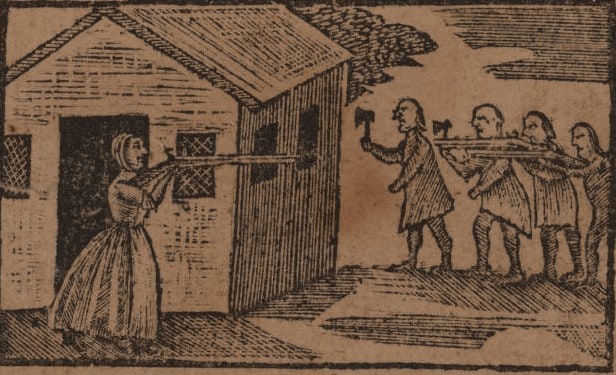In 1675, scarcely 50 years after the first English settlers established themselves in New England, a war broke out between them and the local Native American tribes over land and supremacy. In February 1676, the wife of the minister of Lancaster, Mary Rowlandson, found herself directly caught up in the war when Algonquian tribesmen raided her town. Rowlandson was one of 24 women and children were taken captive by the Indians. She would spend eleven weeks as their captive, walking 150 miles across the New England Wilderness while losing her children: one to death and the other two to enforced separation.
Rowlandson was eventually ransomed and reunited with her surviving children. In 1682, she published an account of her ordeal: “A Narrative of the Captivity and Restoration of Mrs. Mary Rowlandson.” The book was a hit on both sides of the Atlantic, reprinted three times in New England and once in London in its first year alone. Readers reveled in the story of the upright puritan woman who survived amongst heathen savages. Rowlandson, however, had carefully shaped her account to preserve her reputation while ensuring that the Native American tribes came across as unsympathetically as possible. The resulting omissions and glossing over of facts tainted the image of Native Americans for years to come.

King Philip’s War
In 1620, the first English settlers landed on Plymouth Rock in Massachusetts. Unprepared for life in the new colony, the colonists would likely have died if not for the help given to them by the local Native American tribes, led by the Pokanoket chief, Massasoit. However, by the 1670s relations between the settlers and the tribes were not so cordial. As the number of colonists increased, so too did the demand for resources. The settlers began to encroach upon tribal hunting and fishing grounds and attempted to force the tribes to recognize English sovereignty.
Some tribes such as the Mohegan, Pequot, Massachusetts and Nauset Indians remained staunch allies of the settlers. However, cracks began to show amongst relations with other tribes. In November 1675, those cracks finally became a chasm. Indian raiding parties had started to attack military strongholds across New England. Although the Narragansett nation as a whole was not involved in the rebellions, some individual tribesmen did take part. So, the Colonial Militia of Massachusetts, Plymouth and Connecticut declared that the Narragansett people had broken the peace. In winter 1675, a colonial army set off to attack the main Narragansett stronghold. On December 19, they wiped it out.
In response, Pokanoket, Wampanoags, Nipmuck, Pocumtuck and Narragansett tribes allied with the settlers. The colonists knew the Indian’s leader as ‘King Philip,’ after the English name bestowed upon him. However, Philip’s real name was Metacom. He was the sachem or principal chief of the Pokanoket and ironically, the son of Massasoit. Philip was joined in his leadership by his sister in law, Weetamoo, a powerful squaw sachem in her own right. Mary Rowlandson was to encounter both Pokunoket leaders during her captivity. In fact, Weetamoo would own her.

On February 10, 1676, Metacom’s forces raided the town of Lancaster, Massachusetts. The minister of the town, John Rowlandson, was away in Boston but his wife Mary and their three children were in residence as were many of their family and friends. Metacom’s forces brutally killed all but 24 of the inhabitants. The attackers wounded Mary, and her youngest daughter Sarah and the little girl died a week later. Mary’s other two children were then taken from their mother. Rowlandson did not fully reunite with them until her release, eleven weeks later in May 1676, after her husband paid a £20 ransom. That same month, King Philip’s War ended.
The Colonist army had finally destroyed Metacom’s war camp, splitting the tribal alliance. The damage caused by the conflict was devastating. 30% of the English population of New England – some 2500 settlers- had been killed. However, the colonial forces killed 5000 Native Americans. Nor did the Indian’s suffering end there. Indians loyal to the English hunted down Metacom, shooting him through the heart and beheaded him. Some of his supporters escaped to Canada. However, those who surrendered were sold into slavery in the West Indies. Animosity between the settlers and Native American’s was to simmer for years. Rowlandson’s account of her captivity did nothing to alleviate that situation.

